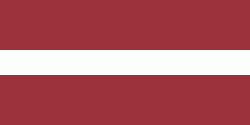Madona
Madona (Modohn) is a town with town rights in the Vidzeme region of Latvia and is the center of the Madona municipality.
The surrounding area of Madona had been populated in earlier times, which is confirmed by discoveries of old burial grounds in the city's vicinity. Madona is first mentioned in writing in 1461, when Archbishop Sylvester began renting the lands of Birži Manor. However, the Swedish government placed the land under state control. After the Great Northern War, Madona became property of the Russian Empire. Empress Elizabeth presented Birži Manor along with other of Vidzeme's manors to Count Alexander Buturlin.
Empress Catherine II bought the lands back as a present to the Serbian-born General Maxim Zorić. From the 19th to the beginning of the 20th century, the location of Madona was the fields of Birži Manor.
According to one version, the name of Madona stems from the adjacent Madona Lake. According to another version, Madona got its name from Birži Manor, which German exonym is Madohn or Modohn. For this reason, the railway station situated at the Pļaviņas - Valka narrow gauge railway line was named Madona as well. The populated place that slowly emerged around the station also got this name after the erection of the Madona railway station in 1903.
Village privileges was given to Madona 1 July 1921, and town privileges 7 June 1926. Since 1 April 1925 Madona was the center of the newly founded County of Madona (Madonas apriņķis). Madona had 1,357 inhabitants at the time.
During World War II, Madona was under German occupation from 2 July 1941 until 13 August 1944. It was administered as a part of the Generalbezirk Lettland of Reichskommissariat Ostland.
The surrounding area of Madona had been populated in earlier times, which is confirmed by discoveries of old burial grounds in the city's vicinity. Madona is first mentioned in writing in 1461, when Archbishop Sylvester began renting the lands of Birži Manor. However, the Swedish government placed the land under state control. After the Great Northern War, Madona became property of the Russian Empire. Empress Elizabeth presented Birži Manor along with other of Vidzeme's manors to Count Alexander Buturlin.
Empress Catherine II bought the lands back as a present to the Serbian-born General Maxim Zorić. From the 19th to the beginning of the 20th century, the location of Madona was the fields of Birži Manor.
According to one version, the name of Madona stems from the adjacent Madona Lake. According to another version, Madona got its name from Birži Manor, which German exonym is Madohn or Modohn. For this reason, the railway station situated at the Pļaviņas - Valka narrow gauge railway line was named Madona as well. The populated place that slowly emerged around the station also got this name after the erection of the Madona railway station in 1903.
Village privileges was given to Madona 1 July 1921, and town privileges 7 June 1926. Since 1 April 1925 Madona was the center of the newly founded County of Madona (Madonas apriņķis). Madona had 1,357 inhabitants at the time.
During World War II, Madona was under German occupation from 2 July 1941 until 13 August 1944. It was administered as a part of the Generalbezirk Lettland of Reichskommissariat Ostland.
Map - Madona
Map
Country - Latvia
 |
 |
| Flag of Latvia | |
After centuries of Teutonic, Swedish, Polish-Lithuanian and Russian rule, which was mainly executed by the local Baltic German aristocracy, the independent Republic of Latvia was established on 18 November 1918 when it broke away from the German Empire and declared independence in the aftermath of World War I. However, by the 1930s the country became increasingly autocratic after the coup in 1934 establishing an authoritarian regime under Kārlis Ulmanis. The country's de facto independence was interrupted at the outset of World War II, beginning with Latvia's forcible incorporation into the Soviet Union, followed by the invasion and occupation by Nazi Germany in 1941, and the re-occupation by the Soviets in 1944 to form the Latvian SSR for the next 45 years. As a result of extensive immigration during the Soviet occupation, ethnic Russians became the most prominent minority in the country, now constituting nearly a quarter of the population. The peaceful Singing Revolution started in 1987, and ended with the restoration of de facto independence on 21 August 1991. Since then, Latvia has been a democratic unitary parliamentary republic.
Currency / Language
| ISO | Currency | Symbol | Significant figures |
|---|---|---|---|
| EUR | Euro | € | 2 |
| ISO | Language |
|---|---|
| LV | Latvian language |
| LT | Lithuanian language |
| RU | Russian language |















